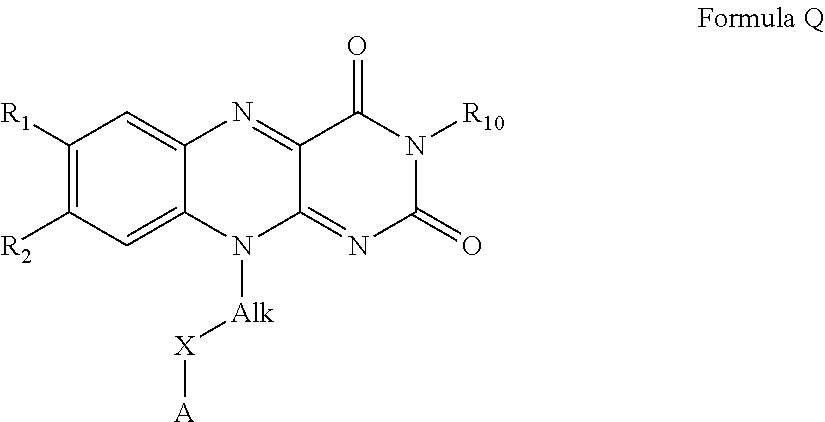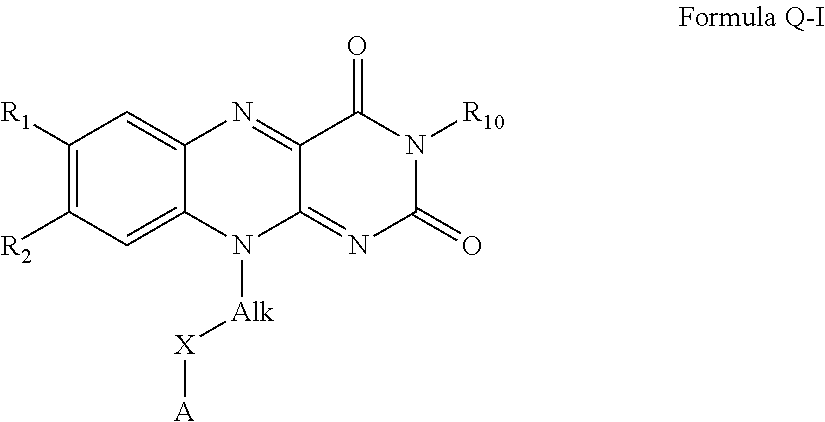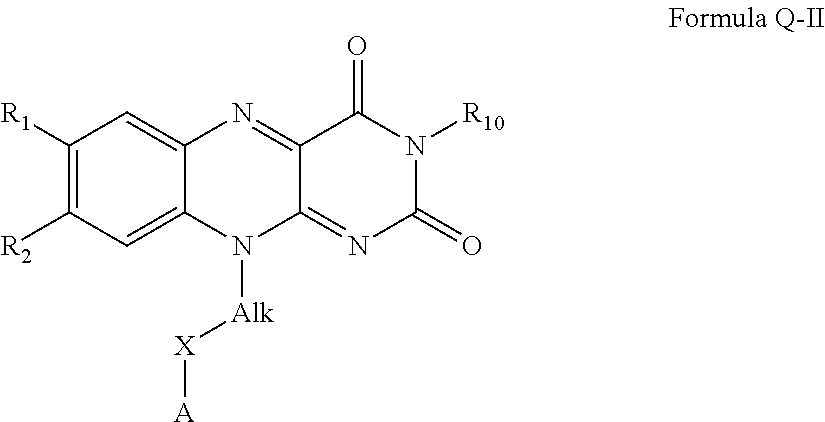Flavin derivatives
a technology of flavin derivatives and derivatives, applied in the field of flavin derivatives, can solve the problems of ineffective antibacterial treatment options currently available, and achieve the effect of reducing the number of side effects
- Summary
- Abstract
- Description
- Claims
- Application Information
AI Technical Summary
Benefits of technology
Problems solved by technology
Method used
Image
Examples
example 1
[0836]An in-line probing assay, as described in Regulski and Breaker, “In-line probing analysis of riboswitches”, (2008), Methods in Molecular Biology, Vol 419, pp 53-67, the contents of which are incorporated by reference in its entirety, is used to estimate the dissociation binding constants for the interaction of each of the ligands described herein with an FMN riboswitch amplified from the genome of Bacillus subtilis or a CD3299 riboswitch amplified from Clostridium difficile. Precursor mRNA leader molecules are prepared by in vitro transcription from templates generated by PCR and [5′-32P]-labeling using methods described previously (Regulski and Breaker, In-line probing analysis of riboswitches (2008), Methods in Molecular Biology Vol 419, pp 53-67). Approximately 5 nM of labeled RNA precursor is incubated for 41 hours at 25° C. in 20 mM MgCl2, 50 mM Tris HCl (pH 8.3 at 25° C.) in the presence or absence of increasing concentrations of each ligand. In-line cleavage products ar...
example 2
[0839]The MIC assays are carried out in a final volume of 100 μL in 96-well clear round-bottom plates according to methods established by the Clinical Laboratory Standards Institute (CLSI). Briefly, test compound suspended in 100% DMSO (or another suitable solubilizing buffer) is added to an aliquot of media appropriate for a given pathogen to a total volume of 50 μL. This solution is serially diluted by 2-fold into successive tubes of the same media to give a range of test compound concentrations appropriate to the assay. To each dilution of test compound in media is added 50 μl of a bacterial suspension from an overnight culture growth in media appropriate to a given pathogen. Final bacterial inoculum is approximately 105-106 CFU / well. After growth for 18-24 hours at 37° C., the MIC is defined as the lowest concentration of antimicrobial agent that completely inhibits growth of the organism as detected by the unaided eye, relative to control for bacterial growth in the absence of ...
example 2a
[0842]The cytotoxic effects of test compounds on HepG2 are measured with a commercially available cell viability assay kit from Promega. On day 1, HepG2 cells (˜1×104 cells) are seeded into each well in 96-well plate and cultured for approximately 24 h at 37° C. in a 5% CO2 atmosphere under saturating humidity. On day 2, test compounds and DMSO controls are added to appropriate wells to give a range of test compound concentrations appropriate to the assay. Terfenadine is also added to each plate as a positive cytotoxic control. Control wells containing medium without cell are prepared to obtain a value for background luminescence. Assay plates are then cultured for approximately 24 h at 37° C. in a 5% CO2 atmosphere under saturating humidity. On day 3, assay plates are removed from 37° C. incubator and equilibrated to 22° C. Once equilibrated, CellTiter-Glo® reagent is added to each well containing cell culture medium, followed by mixing to allow cell lysis. The CellTiter-Glo® Assay...
PUM
| Property | Measurement | Unit |
|---|---|---|
| Minimum Inhibitory Concentration | aaaaa | aaaaa |
| Minimum Inhibitory Concentration | aaaaa | aaaaa |
| Minimum Inhibitory Concentration | aaaaa | aaaaa |
Abstract
Description
Claims
Application Information
 Login to View More
Login to View More - R&D
- Intellectual Property
- Life Sciences
- Materials
- Tech Scout
- Unparalleled Data Quality
- Higher Quality Content
- 60% Fewer Hallucinations
Browse by: Latest US Patents, China's latest patents, Technical Efficacy Thesaurus, Application Domain, Technology Topic, Popular Technical Reports.
© 2025 PatSnap. All rights reserved.Legal|Privacy policy|Modern Slavery Act Transparency Statement|Sitemap|About US| Contact US: help@patsnap.com



